To create your own herbal tea ceremony kit, start by selecting high-quality base herbs like chamomile or peppermint, then add complementary herbs and spices. Choose essential tools including a teapot, strainer, and cups. Craft a tea tray and personalize it with decorative elements. Design aromatic sachets and blend unique combinations. Incorporate mindfulness tools like meditation bells or journals. Learn proper tea ceremony etiquette to enhance the experience. Store your kit in a cool, dry place and maintain it regularly. Share your creation with others, explaining the origins and benefits of your herbal blends. The journey to a perfect tea ceremony awaits your personal touch.
Choosing Your Herbal Tea Ingredients
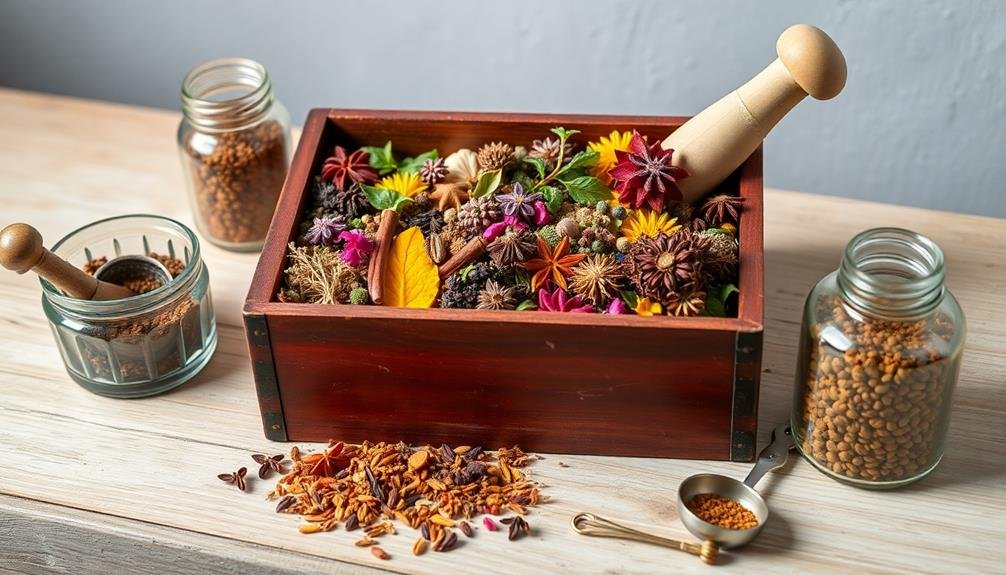
Why settle for ordinary tea when you can create your own unique herbal blends? Selecting the right ingredients is vital for crafting a memorable tea ceremony experience. Start by choosing a base herb, such as chamomile, peppermint, or rooibos. These provide the foundation for your blend and often contribute the primary flavor.
Next, add complementary herbs to enhance the taste and aroma. Consider using lavender for relaxation, lemon balm for a citrusy note, or ginger for a spicy kick. Don't forget about flowers like rose petals or hibiscus, which can add both flavor and visual appeal to your blend.
Explore using spices like cinnamon, cardamom, or star anise to add depth and complexity. For sweetness without calories, try stevia leaves or licorice root. Remember to source high-quality, organic ingredients to guarantee the best flavor and health benefits.
Experiment with different combinations to find your perfect blend. Keep notes on what works well together and adjust ratios as needed. As you become more familiar with various herbs and their properties, you'll be able to create custom blends tailored to specific moods, occasions, or health goals.
Essential Tools for Tea Ceremonies
What tools do you need to elevate your herbal tea ceremony? Start with a high-quality teapot, preferably made of ceramic or cast iron for ideal heat retention.
You'll also need a tea strainer or infuser to separate the leaves from the liquid. Don't forget a set of small cups or bowls for serving your guests.
A tea scoop is essential for measuring the right amount of herbs, while a bamboo whisk is perfect for blending matcha or other powdered teas.
Invest in a tea tray to catch spills and create a dedicated space for your ceremony. A timer will help you achieve the perfect steep, and a thermometer guarantees you're using the correct water temperature for each tea variety.
Consider adding a tea cloth for wiping utensils and a tea pick for breaking apart compressed teas. A small waste bowl is useful for discarding used leaves or excess water.
Selecting the Perfect Teaware
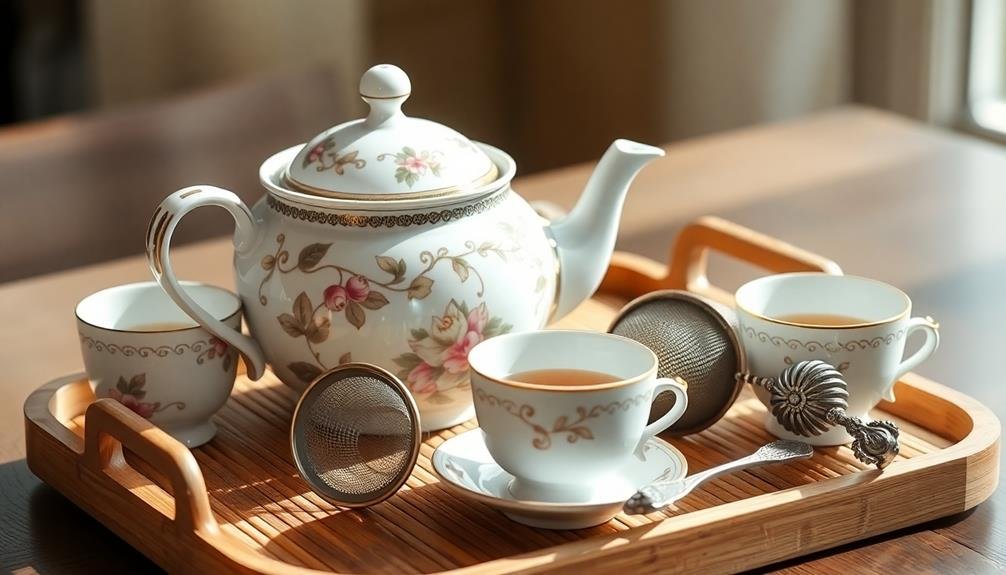
When selecting teaware for your herbal tea ceremony, you'll want to focus on two main categories: brewing vessels and serving pieces.
For brewing, consider teapots and infusers that complement your chosen herbs and brewing methods.
Cups and saucers are essential for serving and should be chosen based on the style of your ceremony and personal preferences.
Teapots and Infusers
Selecting the right teapot and infuser is essential for a successful herbal tea ceremony. Contemplate the material, size, and design when choosing your teapot. Ceramic and glass teapots are popular choices, as they don't affect the tea's flavor. For a more traditional look, opt for a cast iron teapot, which retains heat well.
When it comes to infusers, you've got several options. Basket infusers are versatile and allow ample room for tea leaves to expand. Ball infusers are compact and easy to use, but may restrict leaf expansion. Silicone infusers come in fun shapes and are easy to clean. For loose leaf teas, contemplate a teapot with a built-in infuser for convenience.
Choose a teapot size that matches your needs. A small 2-cup pot is perfect for personal use, while a larger 6-cup pot is ideal for group ceremonies.
Look for teapots with a comfortable handle and a spout that pours smoothly to avoid drips. Don't forget to contemplate the aesthetic appeal of your teaware, as it'll contribute to the overall ambiance of your tea ceremony.
Cups and Saucers
With your teapot and infuser chosen, it's time to focus on the vessels you'll use to sip your herbal tea. Cups and saucers are essential components of your herbal tea ceremony kit, enhancing both the visual appeal and drinking experience.
Consider the material of your cups. Porcelain and ceramic are popular choices, offering excellent heat retention and a smooth surface that won't affect the tea's flavor. Glass cups provide a beautiful view of your brew but may not keep it warm as long. For a more traditional feel, opt for clay or cast iron cups.
Size matters when selecting your cups. Choose ones that hold 4 to 6 ounces, allowing you to enjoy multiple small servings throughout your ceremony. Ascertain the cups are comfortable to hold and have a lip that's pleasant to drink from.
Don't forget the saucers. They not only catch drips but also serve as a resting place for used tea bags or infusers. Select saucers that complement your cups in style and material. For a cohesive look, choose a matching set or mix and match for an eclectic vibe.
Crafting a Tea Tray
Crafting a tea tray is an essential step in creating your herbal tea ceremony kit.
You'll want to start by selecting the perfect tray that complements your teaware and suits your personal style.
Once you've chosen your tray, you can enhance its beauty and functionality by decorating it with carefully selected elements that reflect the ambiance you wish to create.
Selecting the Perfect Tray
The perfect tray sets the stage for your herbal tea ceremony, tying together all the essential elements. When selecting a tray, consider both functionality and aesthetics. Opt for a size that comfortably accommodates your teapot, cups, and accessories without feeling cramped.
Materials like bamboo, wood, or lacquer offer a traditional look, while glass or ceramic trays provide a more modern feel. Choose a tray with raised edges to contain any spills and make carrying easier. If you plan to move your tray frequently, look for one with handles.
Consider the weight of the tray when fully loaded, ensuring you can lift it comfortably. The tray's design should complement your overall tea set. If you have ornate teaware, a simple tray might balance the look. Conversely, a decorative tray can enhance a minimalist tea set.
Think about color coordination as well, selecting a tray that either matches or provides an attractive contrast to your other items. Don't forget practicality. A non-slip surface can prevent accidents, while a waterproof finish will protect the tray from stains and damage.
Decorating Your Tea Tray
Once you've selected the perfect tray, it's time to make it uniquely yours. Decorating your tea tray adds a personal touch and enhances the overall aesthetic of your herbal tea ceremony. Start by choosing a color scheme that complements your tea set and reflects your style. Consider adding a decorative cloth or runner to protect the tray's surface and provide a soft backdrop for your tea items.
Incorporate natural elements like dried flowers, small potted herbs, or polished stones to create a serene atmosphere. You can also add small decorative objects that hold special meaning or represent your cultural heritage. Don't forget to include functional elements like a small dish for used tea bags or a tiny spoon rest.
Here's a guide to decorating your tea tray based on different themes:
| Theme | Colors | Decorative Elements | Accessories |
|---|---|---|---|
| Zen | Earth tones | Bamboo, river rocks | Miniature sand garden |
| Floral | Pastels | Pressed flowers, lace | Porcelain figurines |
| Rustic | Warm neutrals | Wood slices, pinecones | Vintage tea tins |
| Modern | Black & white | Geometric shapes | Sleek metal accents |
Remember to keep your tray uncluttered and functional, allowing enough space for your tea set and accompaniments.
Creating Custom Tea Blends
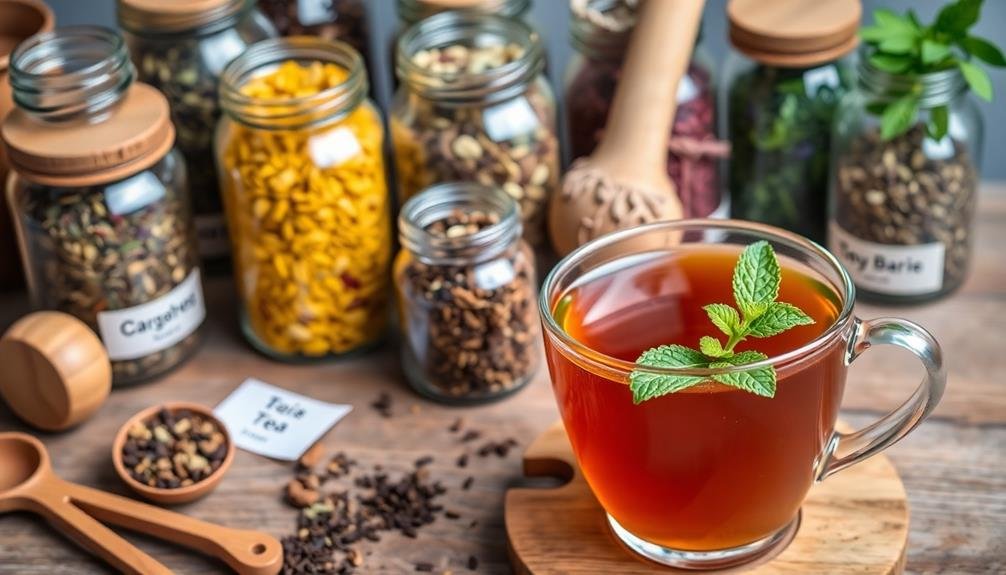
With a dash of creativity and a pinch of experimentation, you can elevate your herbal tea experience by creating custom blends. Start by selecting a base herb, such as chamomile, peppermint, or rooibos.
Then, add complementary flavors to enhance the taste and benefits. Consider using lavender for relaxation, ginger for digestion, or lemon balm for a citrusy twist.
Experiment with different ratios to find your perfect blend. A good rule of thumb is to use 2 parts base herb to 1 part each of additional ingredients. Don't be afraid to mix unexpected flavors – you might discover a unique combination you love.
Keep notes on your blends, recording the ingredients, ratios, and your impressions. This will help you refine your recipes over time.
Store your custom blends in airtight containers away from light and heat to preserve their freshness.
Remember to research the properties of each herb to ascertain they're safe for consumption and don't interact with any medications you're taking.
With practice, you'll develop a personal tea collection that reflects your taste preferences and wellness goals.
Designing Aromatic Sachets
To enhance your herbal tea ceremony kit, you'll want to design aromatic sachets that complement your brews.
Start by selecting fragrant herbs like lavender, chamomile, or mint, then craft small fabric pouches to hold your chosen blends.
Experiment with different aromatic combinations to create sachets that not only smell wonderful but also pair perfectly with your teas.
Selecting Fragrant Herbs
Aromatherapy enthusiasts know that selecting the right fragrant herbs is vital for designing aromatic sachets. You'll want to choose herbs that not only smell pleasant but also complement each other and serve your intended purpose.
Start with classic choices like lavender for relaxation, rosemary for mental clarity, and chamomile for calming effects.
Think about using mint varieties such as peppermint or spearmint for a revitalizing scent, or opt for citrusy herbs like lemongrass or lemon balm to invigorate your senses.
Don't forget about floral options like rose petals or jasmine flowers for a romantic touch. Woody herbs like cedar or sandalwood can add depth to your blend.
When selecting herbs, confirm they're dried thoroughly to prevent mold growth. You can grow your own or purchase high-quality dried herbs from reputable sources.
Experiment with different combinations to create unique scent profiles. Remember to think about any allergies or sensitivities you or your guests may have.
Crafting Fabric Pouches
Crafting fabric pouches is the next step in designing your aromatic sachets. Choose natural, breathable fabrics like cotton, linen, or muslin to allow the scents to permeate. Cut your chosen fabric into small squares, approximately 4×4 inches. Fold the squares in half and sew two sides, leaving one open for filling.
For a decorative touch, you can embroider designs or add lace trim to the pouches. Consider using different colors or patterns to match your tea ceremony aesthetic. Once you've prepared the pouches, it's time to fill them with your chosen herb blends.
| Fabric Type | Advantages | Disadvantages |
|---|---|---|
| Cotton | Affordable, easy to find | May shrink when washed |
| Linen | Durable, becomes softer over time | More expensive |
| Muslin | Lightweight, allows scents to diffuse well | Can be delicate |
| Silk | Luxurious feel, beautiful appearance | Requires gentle care |
After filling the pouches, sew the open end closed or tie it with a ribbon. You can attach small tags to identify the herbs inside each sachet. Store your finished pouches in an airtight container to preserve their fragrance until your tea ceremony.
Blending Aromatic Combinations
When designing aromatic sachets, blending the right combination of herbs and botanicals is essential for creating a harmonious and pleasant scent. Start by selecting a base herb, such as lavender or chamomile, which will form the foundation of your blend.
Then, add complementary herbs and flowers to enhance the aroma and create depth. Consider using rose petals for a floral touch, lemongrass for a citrusy note, or mint for an invigorating twist. Experiment with different ratios to find your perfect blend. A general rule of thumb is to use 2 parts base herb, 1 part secondary herb, and 1/2 part accent herbs.
Don't forget to include aromatic spices like cinnamon, cardamom, or star anise for added complexity. These can be used sparingly, as their scents are often potent. As you mix your ingredients, crush them gently to release their essential oils and enhance the overall fragrance.
Once you've created your blend, store it in an airtight container away from direct sunlight to preserve its aroma. Label your sachets with the ingredients used, so you can recreate your favorite combinations in the future.
Sourcing Organic Herbs
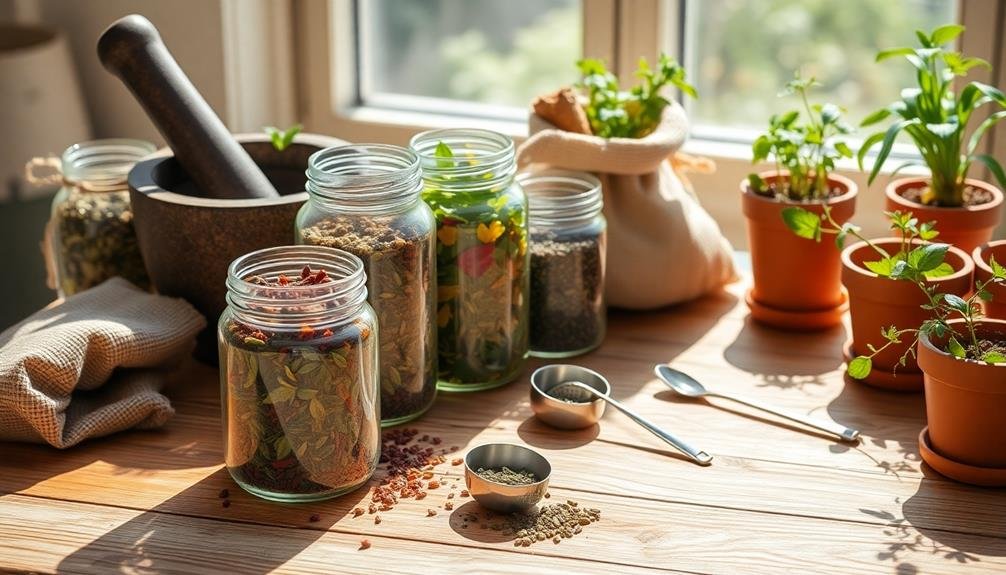
The heart of any herbal tea ceremony lies in the quality of its ingredients. When sourcing organic herbs for your kit, prioritize freshness and purity. Start by exploring local farmers' markets, where you'll often find small-scale growers offering freshly harvested herbs. Don't hesitate to ask about their growing practices and certifications.
If local options are limited, turn to reputable online retailers specializing in organic herbs. Look for companies that provide detailed information about their sourcing and handling processes. Pay attention to packaging dates and opt for herbs sold in small quantities to guarantee maximum freshness.
Consider growing some herbs yourself, even if you have limited space. Many popular tea herbs like mint, lemon balm, and chamomile thrive in small pots or windowsill gardens. This approach assures the freshest possible ingredients and allows you to experiment with unique varieties.
When purchasing pre-packaged teas, choose those with visible, whole leaf ingredients rather than finely ground powders. This guarantees you're getting pure herbs without fillers or additives.
Incorporating Mindfulness Elements
Presence forms the foundation of a meaningful herbal tea ceremony. To incorporate mindfulness elements into your kit, start by including a small meditation bell or singing bowl. These tools can help you shift into a calm state of mind before beginning your ceremony.
Add a mindfulness journal and pen to your kit. This allows you to jot down thoughts, intentions, or reflections before, during, or after your tea ritual. Consider including a set of intention cards or affirmation stones to set a focus for your ceremony.
Incorporate sensory elements that engage multiple senses. Include a small aromatherapy diffuser or incense holder to create a calming atmosphere. Add a soft, natural fabric like silk or linen to use as a tea cloth, enhancing the tactile experience.
Don't forget about visual elements. Include a small vase for fresh flowers or a mindfulness object like a crystal or smooth stone to gaze upon during your ceremony.
Packaging Your Tea Ceremony Kit
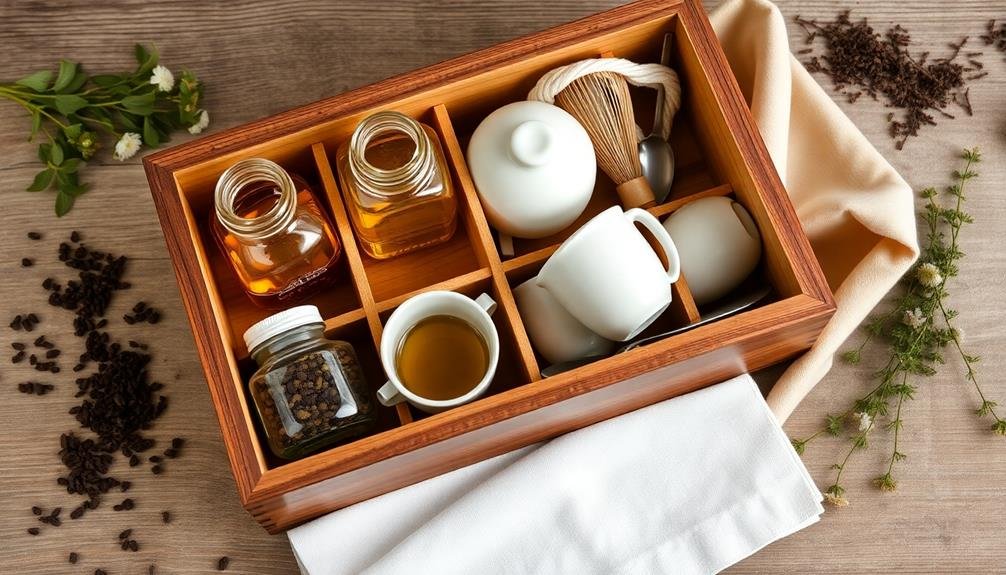
Your tea ceremony kit's packaging is essential for both protection and presentation. Choose a sturdy box or container that's both functional and aesthetically pleasing. Consider using a wooden box, a lacquered tray, or a beautifully crafted basket to house your kit's components. Confirm the packaging is large enough to accommodate all items comfortably while still being portable.
Line the interior of your chosen container with soft fabric or padding to prevent damage during transport. Velvet, silk, or felt are excellent options that add a touch of luxury. Create separate compartments or use small pouches to organize and protect individual items within the kit.
When arranging your kit, consider the order of use during the ceremony. Place frequently used items near the top for easy access.
Here's a suggested arrangement:
- Tea utensils (whisk, scoop, and cloth) on top
- Tea containers and cups in the middle
- Larger items like the kettle or teapot at the bottom
Adding Personal Touches
Personalization elevates your herbal tea ceremony kit from a simple collection of tools to a meaningful, unique experience. Consider adding handwritten notes or cards with tea descriptions, brewing instructions, or personal reflections on each blend.
You can include small decorative elements like dried flowers, colorful ribbons, or handmade ceramic charms to enhance the visual appeal.
Create custom labels for your tea containers using calligraphy or artistic designs that reflect your personal style. Include a journal or notebook for recording tasting notes and memories associated with each tea ceremony.
You might also add a small book of tea-related quotes or poems to inspire mindfulness during the ritual.
Consider incorporating elements from your cultural background or favorite travel destinations, such as a miniature Buddha statue or a small Japanese fan.
Add a personal touch to your teaware by painting or etching designs on cups and saucers. Include a handcrafted tea scoop or a unique tea strainer that reflects your personality.
Tea Ceremony Etiquette Guide
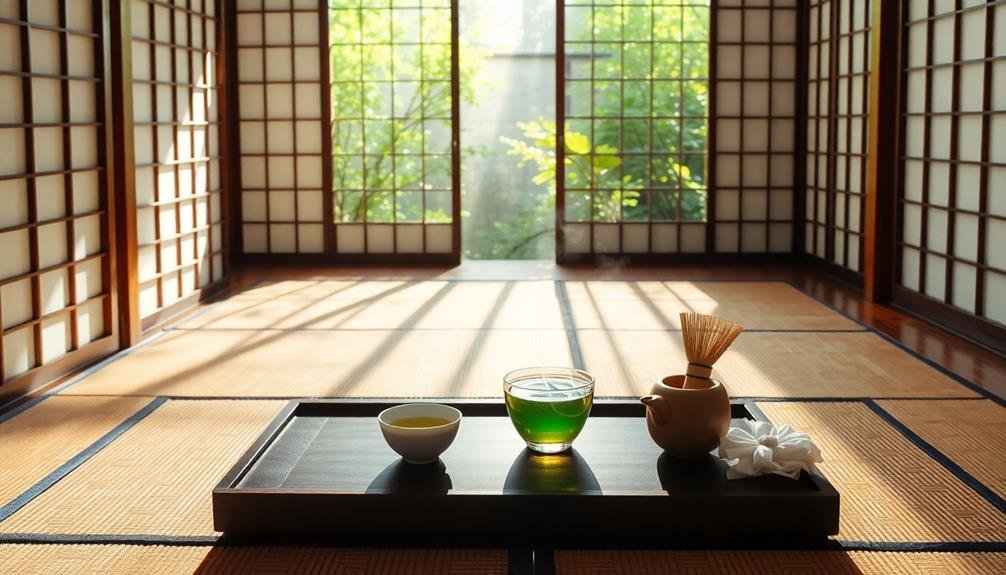
To enhance your tea ceremony experience, understanding proper etiquette is vital.
Begin by creating a calm and welcoming atmosphere for your guests. Remove distractions, play soft background music, and guarantee everyone's comfortable seating.
As the host, you'll need to guide your guests through the ceremony, explaining each step and its significance.
When serving tea, always offer it to your guests first, starting with the eldest or most honored person. Use both hands to present the cup, and encourage your guests to do the same when receiving it.
It's customary to compliment the tea's aroma and flavor, showing appreciation for the host's efforts.
Here are three key points to remember during your tea ceremony:
- Maintain a relaxed and mindful demeanor throughout the ceremony
- Avoid loud conversations or abrupt movements that may disrupt the peaceful ambiance
- Express gratitude to your host or guests for participating in the ceremony
Storing Your Herbal Tea Kit
Proper storage of your herbal tea kit is crucial for maintaining the quality and freshness of its components. Keep your kit in a cool, dry place away from direct sunlight and strong odors. Avoid storing it in the kitchen or bathroom, where humidity and temperature fluctuations can affect the tea's quality.
Store loose herbs in airtight containers, preferably made of glass or ceramic. Label each container with the herb's name and purchase date. For tea bags, keep them in their original packaging or transfer them to sealed containers to prevent moisture absorption.
Clean and dry your teaware thoroughly before storing. Wrap delicate items in soft cloth to prevent scratches or chips. Stack cups and saucers carefully, using padding between each piece.
Keep your tea utensils, such as scoops and whisks, in a separate container to protect them from dust and damage. Store your tea kettle empty and dry to prevent mineral buildup and rust.
Regularly inspect your kit for signs of mold, staleness, or damage. Replace herbs past their prime and address any issues with your teaware promptly to guarantee a consistently enjoyable tea ceremony experience.
Sharing Your Creation With Others

With your herbal tea kit properly stored, you're ready to share your creation with others. Hosting a tea ceremony is an excellent way to introduce friends and family to the art of herbal tea preparation. Begin by setting the scene with a calm, inviting atmosphere. Choose a quiet space, play soft background music, and use natural lighting or candles to create ambiance.
When inviting guests, consider their preferences and any dietary restrictions. Prepare a variety of herbal blends to cater to different tastes. You can also offer accompaniments like honey, lemon, or milk alternatives.
To make your tea ceremony memorable, follow these steps:
- Explain the origins and benefits of each herbal blend
- Demonstrate proper brewing techniques for different herbs
- Encourage guests to engage their senses by smelling and tasting each tea
As you guide your guests through the ceremony, share your knowledge about the herbs' properties and traditional uses.
Encourage discussions about flavors, aromas, and personal experiences. This interactive approach will deepen their appreciation for herbal teas and create lasting memories of your shared experience.
Frequently Asked Questions
Can Children Participate in Herbal Tea Ceremonies?
Yes, children can participate in herbal tea ceremonies. You'll want to choose caffeine-free herbs and guarantee the tea isn't too hot. It's a great way to introduce kids to mindfulness and cultural traditions. Always supervise their participation.
How Long Does a Typical Herbal Tea Ceremony Last?
You'll find that a typical herbal tea ceremony lasts about 30 minutes to an hour. It's flexible, though, and you can adjust the duration based on your preferences and the number of participants involved.
Are There Any Health Risks Associated With Certain Herbal Teas?
Yes, some herbal teas can pose health risks. You should be cautious with certain herbs, especially if you're pregnant, nursing, or taking medications. It's best to consult your doctor before consuming unfamiliar herbal teas regularly.
Can I Use Artificial Sweeteners in My Herbal Tea Blends?
You can use artificial sweeteners in your herbal tea blends, but it's not always necessary. Many herbs have natural sweetness. If you do add them, use sparingly to avoid overpowering the tea's natural flavors.
Is It Possible to Host a Virtual Herbal Tea Ceremony?
Yes, you can host a virtual herbal tea ceremony! Set up a video call, send tea samples to participants beforehand, and guide them through the brewing process. Share tea knowledge, encourage mindfulness, and enjoy the experience together online.
In Summary
You've now crafted your own unique herbal tea ceremony kit. It's a reflection of your personality and tastes, ready to provide moments of tranquility and connection. Don't forget to experiment with new blends and accessories as you grow in your tea journey. Share your creation with loved ones, and you'll create lasting memories. Remember, the beauty of a tea ceremony lies not just in the drink, but in the mindful experience you've curated.

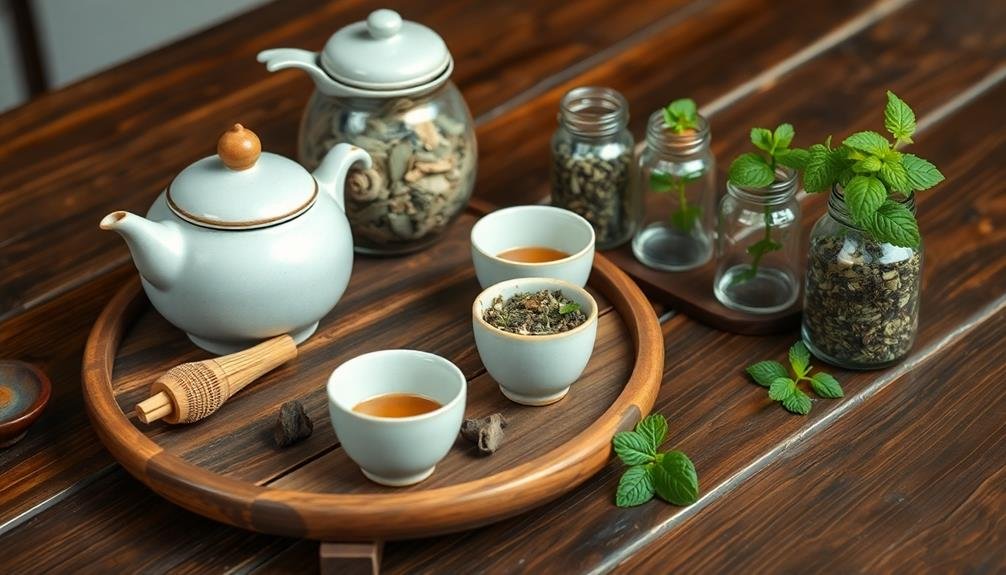
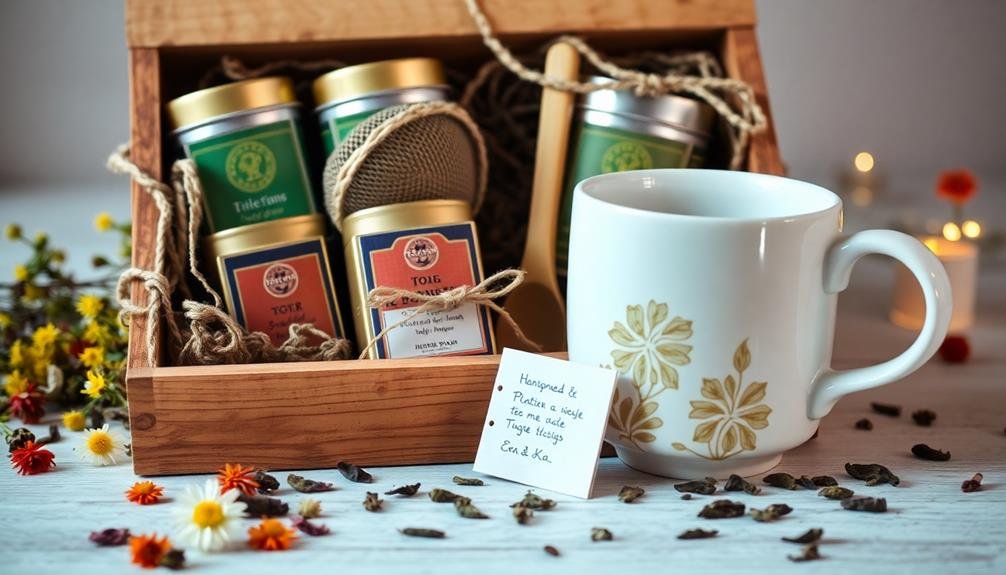
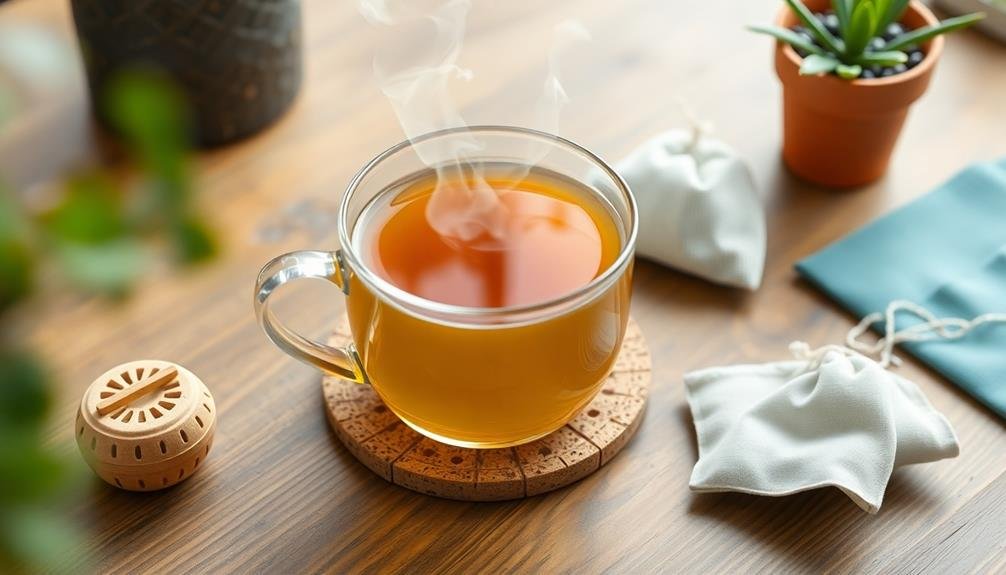
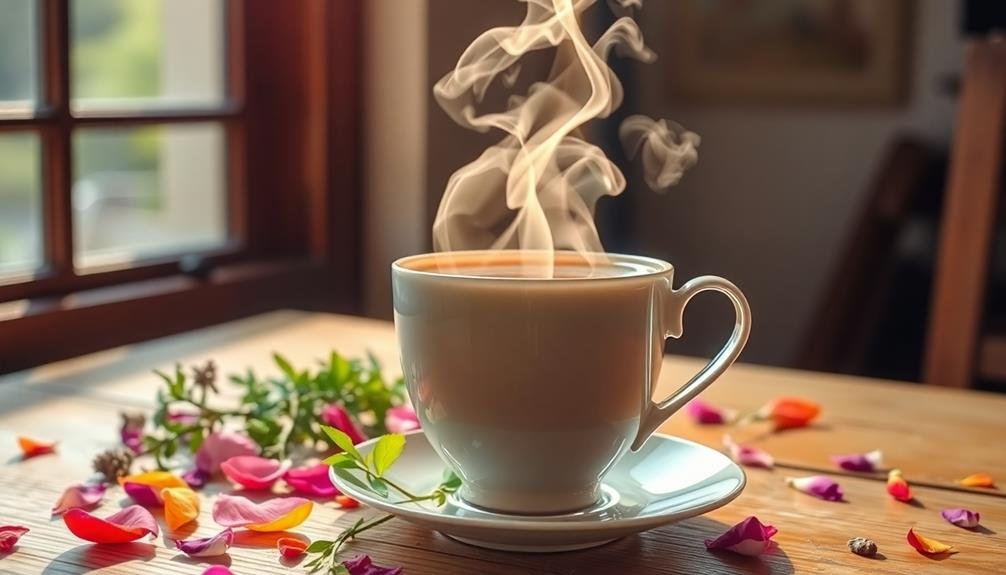
Leave a Reply